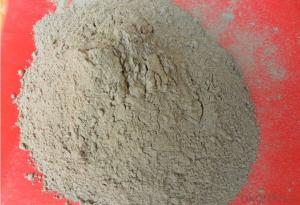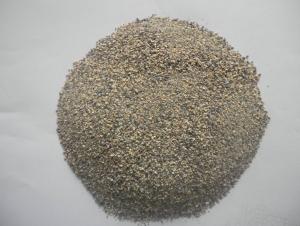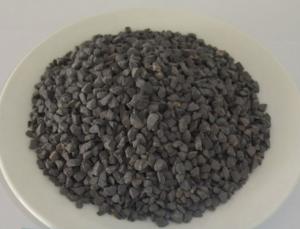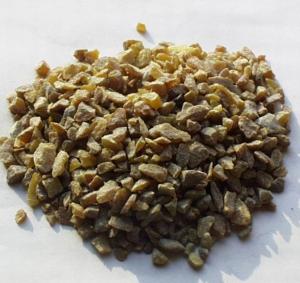High Alumina Calcined Bauxite Ore - Raw Materials for Refractory
- Loading Port:
- Tianjin
- Payment Terms:
- TT or LC
- Min Order Qty:
- 1111 m.t
- Supply Capability:
- 11111111 m.t/month
OKorder Service Pledge
OKorder Financial Service
You Might Also Like
Raw Material High Alumina Calcined Bauxite Ore
1.Structure of Calcined Bauxite Description
Bauxite (aluminous soil; Bauxite) is also called the alumina or bauxite, main ingredients are alumina, hydrated alumina containing impurities, is an earthy mineral. White or gray, brown and yellow or light red by iron. From 4 to 3.9 g/cm3 density, hardness, 1 ~ 3 is not transparent, very brittle. Very difficult to melt. Insoluble in water, soluble in sulfuric acid, sodium hydroxide solution. Mainly used for aluminium, refractory material.
2.Main Features of the Calcined Bauxite
Calcined bauxite is one of the principal ore of aluminum. Calcined bauxite contains hydrous aluminum oxides and aluminum
hydroxides, formed through the laterization of aluminous rocks in tropical and subtropical areas .Calcined bauxite is obtained by calcining (heating)superior grade bauxite at high temperature (from 85OC to 1600C) .This removes moisture there.By increasing the alumina content,compared to an alumina content of about 57%to 58% in raw bauxite, calcined bauxite has an alumina content of 84%to88%.The heating is carried out in rotary kilns.
3.Main usage of the Calcined Bauxite
(1) aluminium industry. Used in national defense, aerospace, automotive, electronics, chemical industry, daily necessities, etc.
(2) precision casting. Alumina clinker made after the mould precision casting processed into fine powder. Used in military industry, aerospace, communications, instrumentation, machinery and medical equipment department.
(3) is used for refractory products. High bauxite clinker refractoriness is as high as 1780, chemical stability strong, and good physical properties.
4. Calcined Bauxite Images


5. Calcined Bauxite Specification
| Place of Origin: | Henan, China (Mainland) | Shape: | Powder | Material: | Bauxite ore |
| SiO2 Content (%): | -- | Al2O3 Content (%): | 87.5% | MgO Content (%): | -- |
| CaO Content (%): | -- | Refractoriness (Degree): | Common (1580°< Refractoriness< 1770°) | CrO Content (%): | -- |
| SiC Content (%): | -- | Model Number: | HQB | Brand Name: | CNBM |
| Name: | High alumina calcined bauxite ore | Company: | CNBM | Type: | R&D- Production-Sales/Manufacture |
| Experience: | 51years | Certification: | ISO,CNAB,IAF | Main markets: | India,South Korea,Denmark, Russia, Europe, the United States |
| Fe2O3: | ≤1.6 | K2O: | ≤0.15 | Na2O: | ≤0.12 |
| Bulk Density: | ≥3.25g/cm3 |
6.FAQ of Calcined Bauxite
1). Q: Are you a factory or trading company?
A: We are a factory.
2). Q: Where is your factory located? How can I visit there?
A: Our factory is located in ShanXi, HeNan, China. You are warmly welcomed to visit us!
3). Q: How can I get some samples?
A: Please connect me for samples
4). Q: Can the price be cheaper?
A: Of course, you will be offered a good discount for big amount.
- Q: What's the fire endurance of fire windows?
- That is fire resistance rating, fire-resistant time in the case of fire! It can be basically classified into the following levels and the fire endurance of the fire window is as follows as well: A class fire window: no less than 1.2h; B class fire window: no less than 0.9h; C class fire window: no less than 0.6h. This is in accordance with the latest specification of gb16809-2008 fire windows.
- Q: How is the grading of the level A new material fire insulation material?
- The standard to distinguish level A and level B is the different fireproofing coefficient. The level A is non-combustible. The level B is divided into B1, B2 and B3. B1 is flame retardant, B2 combustible and B3 flammable. The level A is commonly phenolic aldehyde, rock wool, thermal?mortar, foam ceramics, foam glass and foam concrete on the current market. Among the advantages of level A materials, the biggest one is foam concrete currently, also known as foam cement.
- Q: What refractories are accessible with ease in daily life?
- Refractory mortar. Thermal insulation refractory materials include diatomite products, refractory castables, monolithic?refractories, carborundum bricks, gun-mix refractories, semi-silica bricks, borides, beryllia, silicide, calcium oxide, high alumina refractory brick, refractory coatings, corundum bricks, fireclay?bricks, silicon nitride bonded silicon carbide bricks, chromium hemitrioxide and other refractories. What refractories can be found mostly in the market? Common refractories. Common refractories include silica bricks. The mostly used unshaped refractories include fettling, ramming refractories, castable refractories, plastic refractories, refractory clay, gun-mix refractory, sling refractories, refractory coatings, lightweight refractory castables, stemming etc. The mostly used insulating refractories include diatomite products, asbestos products, insulation panels, etc. The mostly used special refractories include AZS bricks.
- Q: What kind of material is refractory fiber?
- Refractory fiber is good infrared radiation material with good thermal capacity and infrared heating effect. The use of firefractory fiber products can effectively save energy. It is an ideal energy-saving material. Practice has proved that using refractory fiber in continuous industrial heating furnace can save energy of over 15%, and using it in interval industrial heating furnace, it can save energy of more than 30%, while increasing productivity and improving product quality. And make the furnace structure light, large-scale with good comprehensive performance. Refractory fiber is soft and flexible and it is also ideal sealing material. As it has good insulation, sound absorption, anti-oxidation, oil and water resistance and easy construction, it is widely used in metallurgy, building materials, petroleum, chemical, shipbuilding, electric power, aerospace and other fields.
- Q: What is the type of heat resistance property of high temperature electric furnace ?
- According to the levels of refractoriness : Common refractories: & Gt: 1580 ℃ ~ 1770 ℃ advanced refractories: 1770 ℃ ~ 2000 ℃ AAA refractories; 2000 ℃
- Q: What are the application of old refractory bricks?
- It can still be used as refractory bricks or refractory. The quality of auxiliary material is not as good as bauxite.
- Q: How many grades of fire?rating are there for interior decoration materials?
- It can be divided into construction classification and fire resistance rating. Fire prevention for buildings. Fire prevention measures should be taken in the architectural design to prevent fires and reduce fire hazards to life and property. Building fire protection includes two aspects: fire prevention before fire disaster and measures in fire disaster, among which the former is mainly to confirm the fire resistant rating and fire-resistant structure.
- Q: What's the material of fireproof and wear-resisting floor?
- 1. It is the kind of special concrete floor, and its production process is the same with that of the common concrete floor, but it uses different material which needs to be the pebbles and sand after processing with marbles and dolomite. 2. Fireproof floor is a kind of decorative material which is laid on the ground of the factory or large areas of floors. It does not support combustion or it is composed of flame retardant materials. Fireproof floor has two categories. One is composed of aggregate wear-resistant material which is solid particulate matter. Its construction method is to evenly spread aggregate wear-resistant particles on the surface layer of the concrete when the floor is just pouring concrete and solidified, and then a firm flame retardant layer will be formed on the surface layer. This is the the so-called carborundum wear-resisting floor. But this kind of material has many limitations and can only be used on the surface of the just poured concrete. In addition, it is easy to fade in color and not beautiful in appearance. So this is not fireproof floor in the strict sense. Here we focus on a new liquid coating fire protection floor, which is environment friendly, widely used and beautiful in appearance. 3. Wear-resistant floor has the characteristics of pressure resistance, strong wear resistance,oil resistance, and anti-infiltration. It is also dust-free and easy to clean. After entering the initial setting of concrete, construction can be started immediately. Construction period is usually longer, but better using effect will arise.
- Q: What types does refractory floor include?
- There are many types refractory bricks, including silicon aluminum refractory brick, the leading product in refractory bricks. And its high temperature resistance can reach up to 600 degree centigrade or more, so it is an excellent refractory brick. And this high-alumina refractory brick is very suitable for metal industry for its strong practicability. Another one is alkaline series refractory brick, including magnesite refractory brick, and these two bricks are good materials resistant to high temperature.
- Q: Does anyone knows which company produces the better refractory materials?
- 1, Xinjiang Seekon new material limited liability company: Xishan Street No. 382,Saybagh District 2, Refractory Material Co., Ltd. In Xuyan, Benxi: Near the Sihu Road, Benxi City 3,Benxi Beitai new refractory material factory sales office address: Benxi city Sihu District Liu Toro No. 16
Send your message to us
High Alumina Calcined Bauxite Ore - Raw Materials for Refractory
- Loading Port:
- Tianjin
- Payment Terms:
- TT or LC
- Min Order Qty:
- 1111 m.t
- Supply Capability:
- 11111111 m.t/month
OKorder Service Pledge
OKorder Financial Service
Similar products
Hot products
Hot Searches
Related keywords































